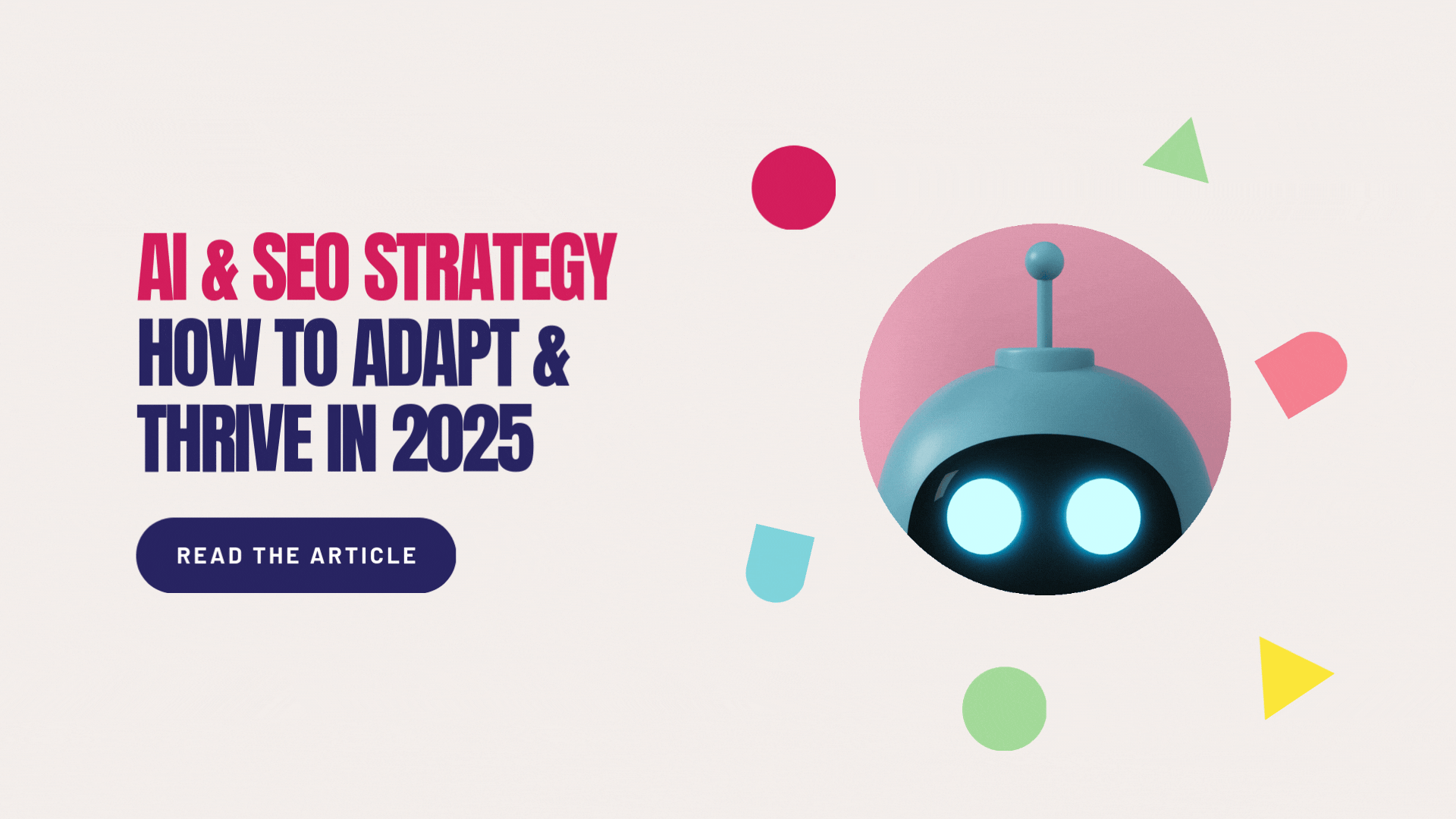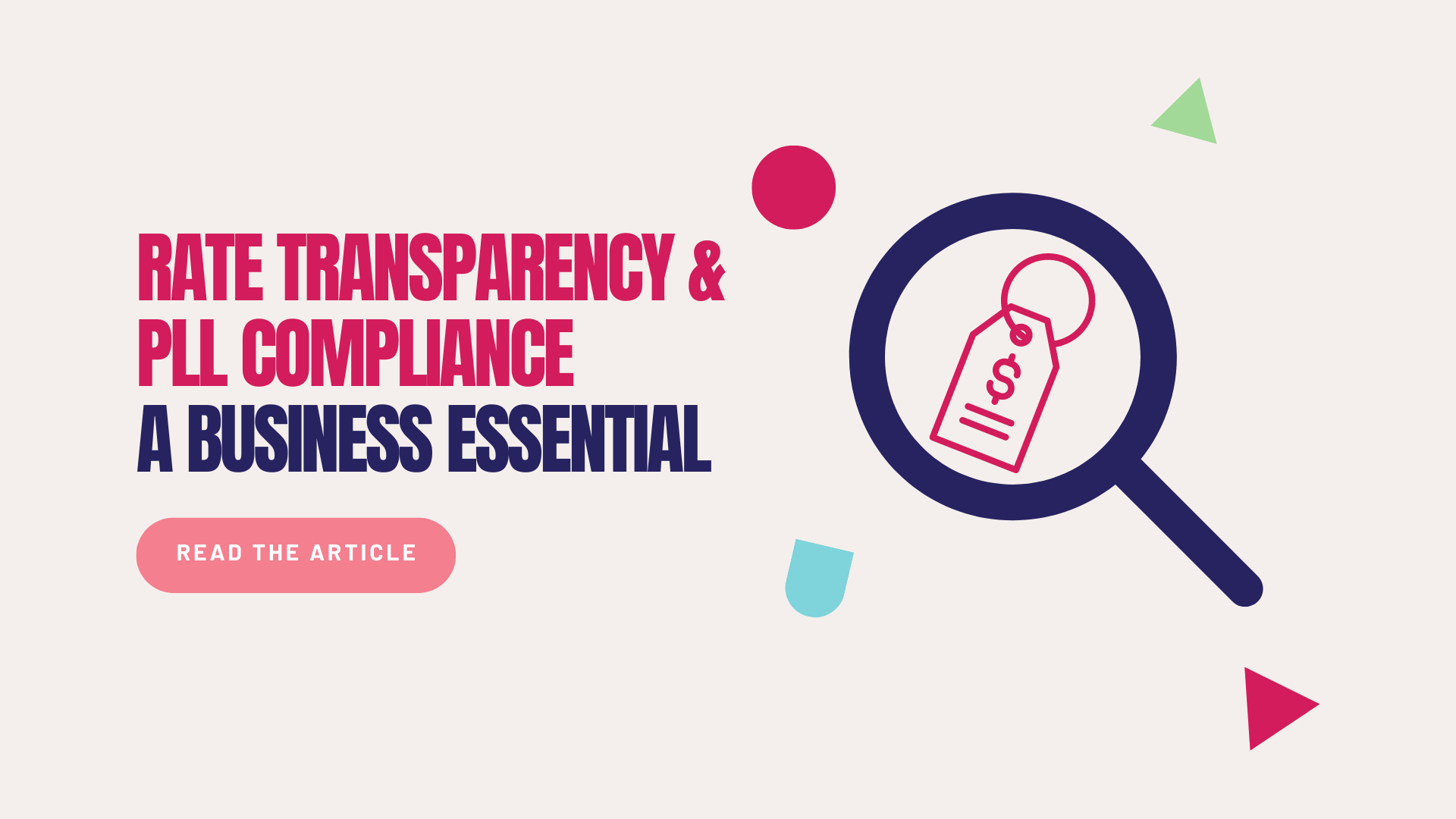AI is shaking up SEO faster than a food truck flipping pancakes at a Sunday brunch.
Shaken, but not stirred, marketers and business owners are looking for a playbook that’s not just theoretical but actually actionable.
We’ve got you!
This article will break it down—what’s happening, how to adapt, and what successful brands are doing.
Table of Contents
What Is AI SEO?
The definition of AI SEO (Artificial Intelligence Search Engine Optimization) is hazy.
Most define AI SEO as the use of artificial intelligence technologies to enhance and automate various aspects of search engine optimization.
However, the market seems to be adopting the term differently.
Most of our clients have been asking about AI SEO, eager to know how they can optimize for rather than with AI tools.
They see AI SEO as a set of tactics that can help them improve their content’s visibility on AI-generated overviews on search engines and AI chatbots.
This, along with other numerous questions surrounding AI and SEO, only speaks to the nascence of the AI search technology and relative unpredictability of its impact on traditional SEO.
Alas, worry not!
SEO experts like us (hello, we’re Digital Spice 👋) have been working with these tools and following the trends closely for long enough to clarify some of the confusion and offer actionable tips with confidence.
Let’s dig in.
→ You may also like: Franchise SEO Master Guide
How Is AI Impacting Search Engines?
Search engines are no longer just ranking web pages—they are actively choosing and presenting content in ways that fundamentally change how users interact with search results.
AI-driven features like AI Overviews and conversational search are reshaping visibility, engagement, and organic traffic.
Here’s a look at the most significant AI advancements and their impact on websites:
1. AI Overviews: The Rise of Zero-Click Searches
Google’s AI Overviews, an evolution of its Search Generative Experience (SGE), are designed to answer user queries directly within the search results rather than directing users to external websites.
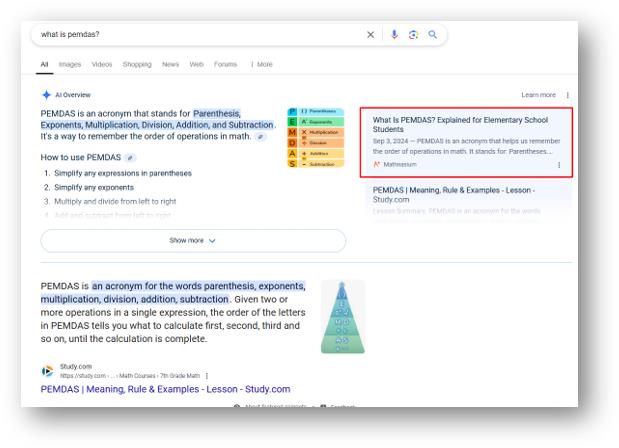
Google’s AI Overview in action: An example from Digital Spice’s SEO kitchen
These AI-generated summaries pull information from multiple sources, synthesizing key points into a quick-response format.
How it works:
- Google’s AI scans multiple web pages, selecting authoritative and relevant content.
- It generates a concise summary, often without requiring users to visit the original sources.
- These AI Overviews appear at the top of search results, competing directly with organic links.
Not all searches generate AI Overview results, of course. As of today, AI Overviews show up for:
- Complex Questions: Queries that require synthesizing information from multiple sources, such as ” What are the benefits of high dosage tutoring to math students?”
- Informational Searches: General knowledge queries seeking explanations or definitions, like “What are the symptoms of arthritis?”
- Question-Based Queries: Searches starting with words like “what,” “why,” “how,” “when,” and “where,” for example, “How does photosynthesis work?”
- Problem-Solving Queries: Searches seeking solutions or troubleshooting advice, such as “How to make a martini that is shaken, not stirred?”
- Health and Safety Topics: Queries related to health conditions or safety procedures, like “First aid steps for choking.”
While AI overview facilitates users’ search journey, it has come at the expense of traditional website traffic for website owners, as users no longer need to click through to external sites.
So, how are AI Overviews impacting websites?
- Declining Click-Through Rates (CTR): Users get their answers instantly, leading to fewer clicks on traditional organic search results.
- Increased Competition for Visibility: Only the most authoritative or AI-friendly content gets referenced in Overviews.
- Greater Emphasis on Structured Data: AI favors content that is well-structured, clear, and easily extractable.
How to adapt?
Just play by Google’s official playbook!
We’ve seen this time and again: Anyone who tries to hack their way into the top of SERPs may see success, but it is guaranteed to be short-lived.
So, be smart and listen to Google when they say:
- Build brand authority to increase the chances of being cited in AI Overviews.
- Optimize for structured data and schema markup to improve content visibility.
- Create in-depth, experience-driven content that AI cannot easily summarize.
2. Bing’s ChatGPT Integration: Conversational Search Takes Over
Microsoft’s Bing has integrated OpenAI’s ChatGPT into its search engine, shifting towards conversational AI-powered responses rather than static link-based results.
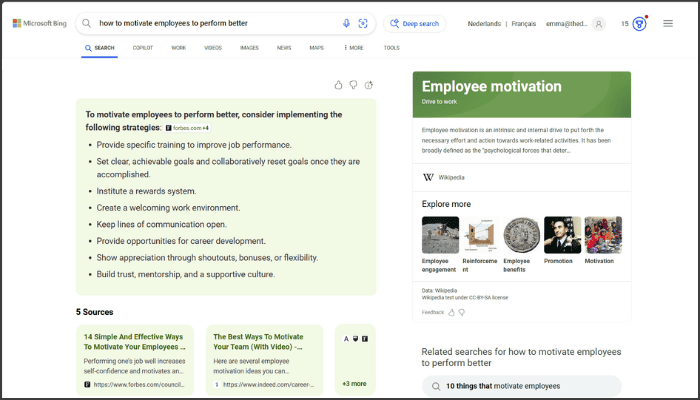
Bing’s AI-Generated result, powered by ChatGPT
This represents a major evolution in search behavior, with users engaging in back-and-forth interactions instead of one-time searches.
How it works:
- Bing’s AI processes queries using natural language processing (NLP) to understand user intent.
- Instead of listing links, it generates detailed, context-aware responses.
- Users can refine their queries within the chat interface for more precise answers.
Much like Google’s AI Overview, Bing’s AI-generated responses show up for informational and complex queries, including iterative and visual searches:
- Iterative Searches: Queries that involve follow-up questions, like “how to start a podcast” followed by “equipment needed for podcasting,” where Bing’s AI maintains context across interactions.
- Visual Searches: Image-based searches, where users upload a picture to find related information, and Bing’s AI analyzes the image to provide relevant results.
How does the AI feature impact search experiences on Bing?
Similarly to Google, Bing now favors natural language and context over keywords.
- Less Reliance on Traditional Ranking Factors: Search engines prioritize contextual, well-structured content over exact keyword matches.
- Greater Demand for Conversational Content: Static content struggles to rank unless formatted in a conversational, question-answer style.
- Opportunities for AI-Optimized SEO: Businesses that align their content with natural language queries stand a better chance of being referenced.
This means surface-level SEO tactics are becoming less effective. The more relevant, unique, contextually rich content you can provide, the greater its chances for ranking.
How to adapt:
- Write content that mimics natural language queries and long-tail keywords.
- Optimize for FAQ-style answers that match AI-generated responses.
- Use AI-powered SEO tools to analyze and adjust content based on semantic search trends.
AI and Search Engines: Friends or Foes?
If you’ve been trying to figure out whether AI is going to overthrow traditional search engines or simply evolve them, we’re right there with you!
Luckily, we’ve been in this business for a while and the AI-powered tools have been simmering in the market for enough time to give us enough insight so we may attempt to answer questions like:
- What role will AI chatbots like ChatGPT, Claude, and Grok play in search?
- How are these impacting the
- Where is this whole thing going and how can we futureproof our SEO strategy?
Let’s explore the relationship between AI platforms and search engines.
Are AI Chatbots Replacing Search Engines?
AI chatbots aren’t replacing Google and Bing… just yet.
But they are changing how people search for information.
While traditional search engines provide ranked lists of sources, AI chatbots generate direct, conversational answers based on vast amounts of training data.
AI chatbots are evolving incredibly fast, but they still:
- Lack real-time indexing of the web, meaning they may provide outdated or incomplete answers.
- Are synthesizing responses from multiple sources but don’t always cite original authors—a major difference from search engines.
- Are not ideal for discovery-based searches, where users benefit from multiple perspectives and sources.
This is why users tend to rely on both tools simultaneously: Search engines for quick, easily verifiable information, and AI chatbots for exploration, conversational queries, and content creation.
(If you’re wondering, yes, we have used AI chatbots to create this article and, yes, we did fact-check everything on search engines 😉).
Will AI chatbots ever replace search engines fully?
Judging by the search engine market trends, this seems unlikely.
Will AI Shrink the Search Engine Market?
Some speculate that AI tools could reduce the need for search engines, but recent trends suggest a different story—one of evolution rather than replacement.
AI’s influence on investor confidence has been significant. When AI-driven innovations make headlines, stock prices often react accordingly. For instance, BuzzFeed’s announcement to integrate OpenAI technology into content creation led to a 120% surge in its share price, underscoring market enthusiasm for AI adoption.
However, the risks of AI-generated misinformation have also had consequences. In February 2023, Google’s premature launch of Bard included factually incorrect responses, leading to concerns over AI reliability. Alphabet’s stock took a hit following the blunder, highlighting just how critical accuracy and trust are in AI-driven search.
But what about user behavior?
Despite this turbulence, Google remains dominant, but its market share has seen a gradual decline since the launch of ChatGPT.
In October 2022, a month before ChatGPT’s launch, Google’s market share stood at 92.34%, while Bing held just 3.59%.
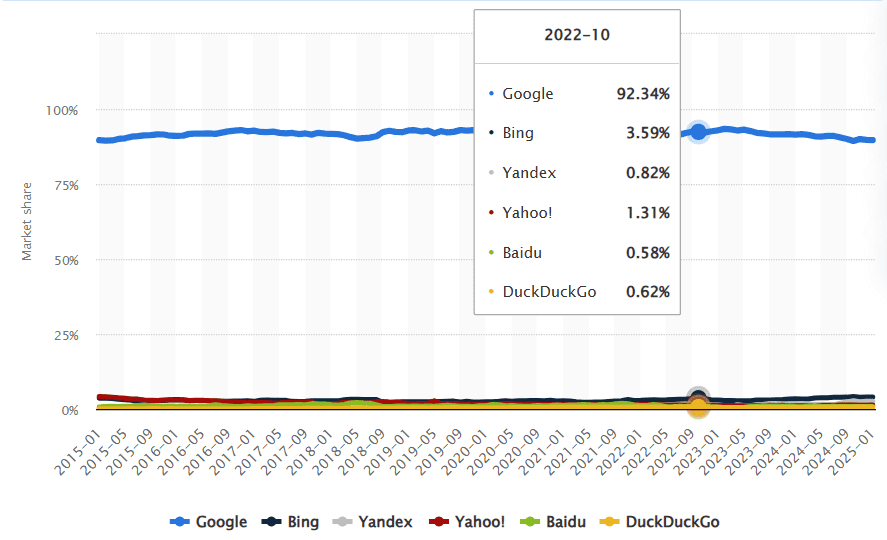
(Source: Statista, 2025)
Since then, Google’s share has dipped to 89.62%, while ChatGPT-powered Bing has climbed to 4.04%.
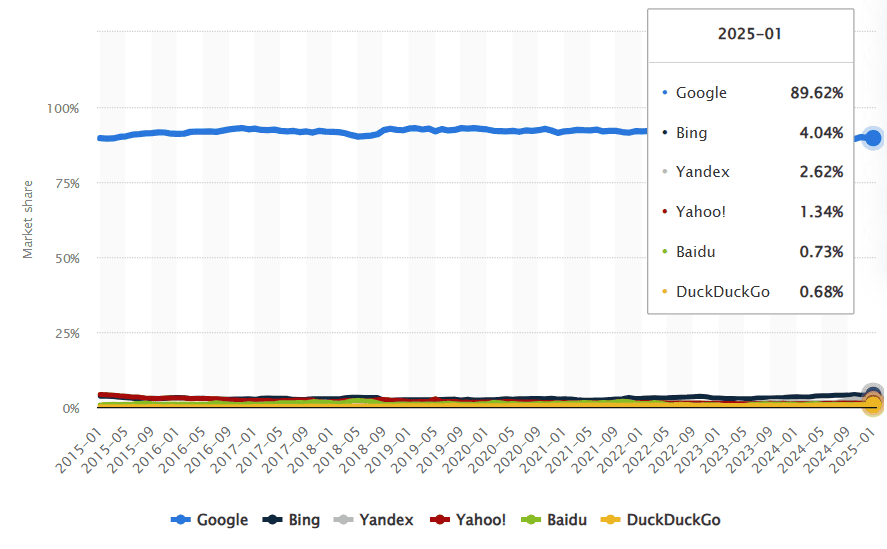
(Source: Statista, 2025)
Surprisingly, however, Business Insider experts found that Google’s queries have grown over 20% between 2022 and 2024, i.e. following the launch of ChatGPT.
What does this say about the future of AI and SEO?
While the market shift is not dramatic, it suggests that AI integration is making search engines more competitive rather than replacing them altogether.
For businesses, this means that SEO is not dying—it’s evolving.
Instead of replacing search, AI is making it more dynamic, personalized, and competitive—a shift that smart marketers can leverage to their advantage.
Let’s see how!
AI SEO Requirements: How to Make Your Website AI-Friendly
Tired of vague tips?
We feel you!
Here are some very specific, actionable steps you need to take if you want your content to perform better with features like AI Overviews and on AI chatbots alike.
These are your must-haves:
1. Website Performance: Ensure Fast Load Times and Mobile-Friendliness
Fast-loading, mobile-friendly websites are favored by AI-driven search engines, as they enhance user experience.
To optimize your site’s performance:
- Use Tools Like Google PageSpeed Insights: Analyze your site’s speed and receive actionable recommendations.
- Implement Mobile-First Design: Ensure your website is responsive and performs well on mobile devices, aligning with Google’s mobile-first indexing approach.
-
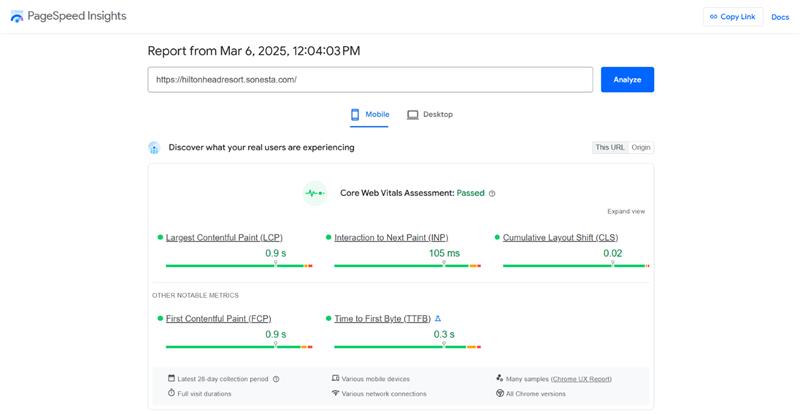
Ensure your website’s Core Web Vital metrics are in green. Here’s an example of a PageSpeed Insights for the website we recently launched: Sonesta Resort Hilton Head Island
→ You may also like: Website Performance Compliance Guide
2. Security: Use HTTPS to Secure Your Site
Securing your website with HTTPS is a critical trust signal for both users and search engines. HTTPS encrypts data between the user and your site, protecting sensitive information.
Implementing HTTPS can also positively impact your SEO rankings, as search engines prioritize secure sites.
3. Structured Data: Implement Schema Markup to Provide Context
Structured data, or schema markup, helps AI understand your content’s context, leading to enhanced search visibility.
Adding more detail to you search result, schema markup can also increase click-through and, consequently, organic traffic.
To implement structured data:
- Utilize JSON-LD or Microdata Formats: These formats are recommended for adding schema markup to your HTML.
- Leverage Google’s Structured Data Markup Helper: This tool assists in generating accurate schema code for your content.

Ratings and pricing schema can increase your visibility and click-through in search
4. Accessibility: Ensure the Site Is Accessible to All Users
Making your website accessible to users with disabilities improves user experience and complies with legal standards.
To enhance accessibility:
- Follow WCAG Guidelines: Adhere to the Web Content Accessibility Guidelines (WCAG) to ensure your site meets accessibility standards.
- Implement ARIA Roles: Use Accessible Rich Internet Applications (ARIA) roles to define elements, making navigation easier for assistive technologies.
- Validate Your Code: Ensure your HTML and CSS are error-free to prevent accessibility issues.
→ You may also like: ADA Compliance Guide to Creating an Inclusive Website
5. Readability: Ensure the Main Content Is Presented in HTML or Server-Side Rendered JavaScript
AI crawlers prioritize content that is easily accessible and indexable.
To improve readability:
- Present Core Content in HTML: Ensure that essential text and data are directly included in the HTML, as AI crawlers may not process client-side rendered content effectively.
- Use Server-Side Rendering (SSR) for JavaScript: If your site relies heavily on JavaScript, implement SSR to deliver fully rendered pages to the client, enhancing crawlability and load times.
How to Make Your SEO Strategy AI-Friendly
Once you’ve taken care of the essentials, we can talk SEO strategy.
The good new is:
If you’ve followed SEO best practices, prioritized your users’ search intent and experience, and worked on building your brand’s topical authority and visibility in search, you are already on a good track!
As we said earlier, hacking your way to the top is not a sustainable strategy in SEO.
Those who have played the long-game need only build upon their strategy to continue to reap the benefits on search engines.
Let’s look at some specific SEO tactics and best practices to focus on for better visibility in AI-powered search:
1. User Intent Focus
Prioritize understanding and addressing user intent over mere keyword matching. This approach ensures your content aligns with what users are genuinely seeking.
For example, instead of targeting the keyword “faucet repair,” create content that answers the query “how to fix a leaky faucet,” providing step-by-step guidance.
So, keyword-steroid days are over. Stop pumping terms and start anticipating and answering questions.
→ You may also like: How LinkedIn Leveraged AI & UGC to Dominate the SEO Game in 2023
2. Conversational SEO
Optimize your content for natural language and long-tail keywords to match the conversational queries users input into search engines.
While a lot of these long-trail queries may show low search volumes, think value over volume!
The more specific a question is, the higher the (purchasing) intent is.
Just compare queries like “hotels in Atlanta,” and “pet-friendly hotels in Atlanta with family-friendly suites and free breakfast” — safe to say that the first user is at the start of their long hotel search journey, while the second is clicks away from choosing and reserving their hotel stay.
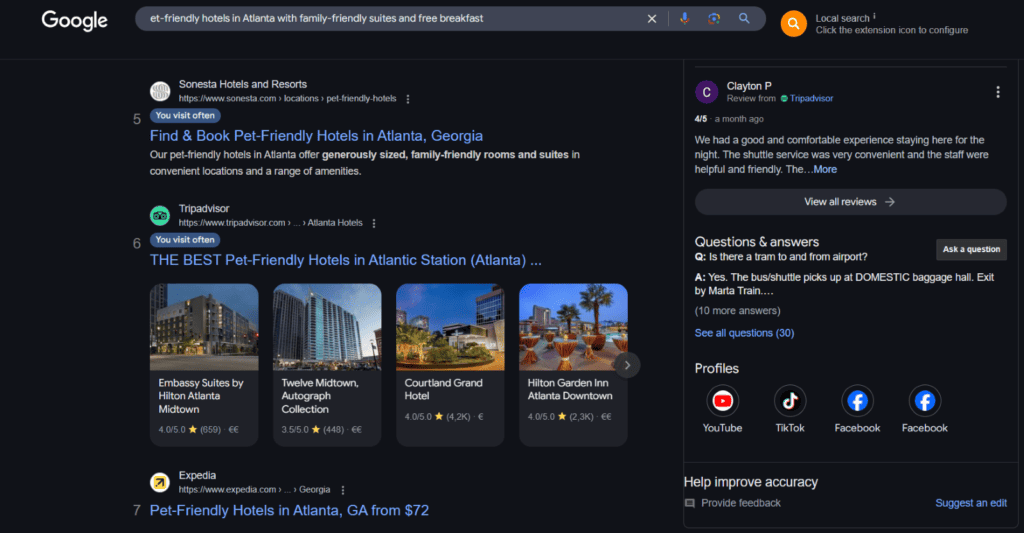
An example from our kitchen: Sonesta’s pet-friendly hotels in Atlanta page outranks the titans like TripAdvisor and Expedia for long-tail keywords.
The more context you provide to search engines, the more likely you are to rank for conversational queries and outperform competitors.
3. AI-Driven Content Analysis
If you’re new to SEO, ” help will always be given at Hogwarts to those who ask for it.”
Utilize AI tools to analyze and optimize your content for AI-powered search results. These tools can provide insights into content structure, keyword usage, and overall SEO performance.
Recommendation: Tools like Surfer and Ahrefs offer content optimization features, helping you align with AI search algorithms.
4. Multimedia SEO
Optimize images, videos, and other media types for AI interpretation to enhance search visibility.
Here’s how:
- Alt Text for Images: Provide descriptive alt text for images to help AI understand visual content.
- Video Schema Markup: Implement schema markup for videos to improve their discoverability in search results.
5. Ethical Practices
Again, repeat after us: “Hacking your way to the top isn’t a sustainable strategy.”
Search engines favor those who bring real value to the table.
Ensure your content is original and adheres to ethical standards, avoiding AI-generated spam. This practice maintains credibility and aligns with search engine guidelines.
Follow ethical content creation practices to avoid penalties from search engines.
6. Voice and IoT SEO
Optimize your content for voice search and Internet of Things (IoT) devices to cater to the growing number of users relying on voice-activated technology.
Here’s how:
- Conversational Keywords: Incorporate natural language phrases that users might speak into voice-activated devices.
- Structured Content: Format content to answer common voice search queries directly, enhancing compatibility with voice assistants.
7. Dynamic Adaptation
Maintain flexibility in your SEO strategies to adapt to the rapid advancements in AI technology. Regularly monitor your reports and updates and adjust your approach accordingly.
Stay informed about AI developments to anticipate changes in search algorithms.
At Digital Spice, some of our favorite outlets are:
- https://www.searchenginejournal.com/
- https://www.seroundtable.com/
- https://www.semrush.com/blog/
- https://ahrefs.com/blog/
8. Knowledge Graph Integration
Utilize structured data to integrate your content into search engine knowledge graphs, enhancing visibility and authority.
Apply schema markup for FAQs and other relevant content types to facilitate inclusion in knowledge graphs.
9. Personalization
Personalization goes both ways with AI:
You can allow AI-powered platforms to deliver personalized recommendations to users by offering them a wealth of information about your brand, products, and services.
You can leverage AI tools to personalize your users’ experience on your brand’s owned or managed channels.
Incorporate elements that allow for personalized content or recommendations, enhancing user engagement and satisfaction. AI can analyze user behavior, search history, and on-site interactions to tailor content in real time.
How to implement:
- Use AI-driven analytics tools (e.g., Google Analytics, BrightEdge) to track user interests and browsing patterns.
- Implement dynamic content recommendations, such as personalized product suggestions in e-commerce or customized blog/article recommendations based on past reading behavior.
- Adapt email marketing and landing pages based on user preferences and past interactions, increasing engagement and conversion rates.
→ You may also like: Fixing the Leaky Funnel with Email Marketing [Franchise Guide]
AI SEO Services: Brought to You by Digital Spice
This guide has been brought to you by Digital Spice, a creative digital agency specializing in SEO, web design, and digital marketing.
Guided by the latest insights, industry best practices, and expertise, we help businesses increase their visibility and organic traffic through a combination of technical, on-page, off-page, and local SEO strategies.
Whether you’re looking to optimize for AI-driven search engines, enhance your content strategy, or futureproof your online presence, our experts have the recipe for success.
🌶️ Ready to spice up your SEO strategy?
Let’s craft a custom plan for your business. Get in touch with us for a free proposal today! 🚀





